[ Retro Scan ] Milton-Bradley MBX for TI-99/4A
June 15th, 2017 by Benj Edwards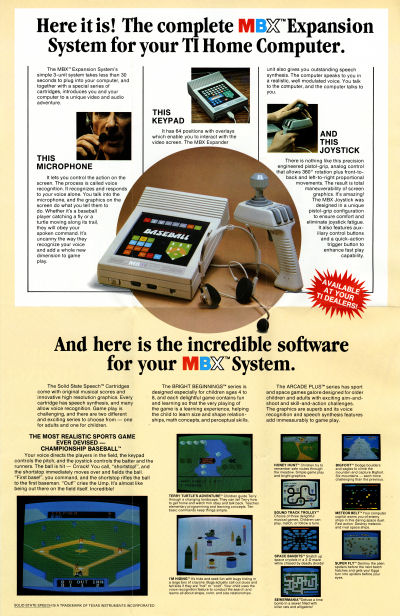 Milton-Bradley MBX Flyer: Side 2
Milton-Bradley MBX Flyer: Side 2
The Milton-Bradley MBX, launched around 1983 for the TI-99/4A home computer, is a strange product: it combines a pistol-grip joystick with a rotating knob and analog control, a 64-position touch pad with overlays, and voice-recognition headset into one package that is supposed to enhance gameplay on specially-designed TI-99/4A games.
This neat TI-99/4A site has a history page about it, so I think I’ll just snatch a portion that explains the MBX’s origins:
Now that you have an idea as to what the MBX System is, below is a little history provided by Mike Langieri (the creator of the device). According to Mike, the MBX actually started out as a stand-alone game console in 1982 and was to be Milton Bradley’s answer to the Atari 2600 and Intellivision. MB’s plan was to provide the game player with voice recognition, speech synthesis, and an action-input keypad which in turn would give them an advantage over the systems already on the market.
Now how come MB did not go ahead with their own system in 1982? Once the Colecovision came out, Jim Shea (then president of Milton Bradley) thought that the market was not big enough to support 4 game systems from Atari, Mattel, Coleco, and Milton Bradley and therefore killed the project. However, so much development went into creating MB’s own video game unit that Mike was then assigned to finding a use for all the technology they developed.
Eventually it was decided to transform Milton Bradley’s gaming system to an add-on for the TI-99/4A, most likely due to the fact that MB had earlier developed the Gamevision line of video games for the 99/4A
and also created the graphics chip used inside of the TI system.Thus, “the MBX was the phoenix that rose from the ashes” as Mike wonderfully put it.
It’s amazing to think “What if” and wonder what a Milton-Bradley game console might have been like. I believe that Milton Bradley also originally tried to sell this idea to Atari, but they declined, and it ended up as a TI-99/4A peripheral. A non-rotating, non-analog variation on this joystick did end up as Atari’s Space Age joystick, though.
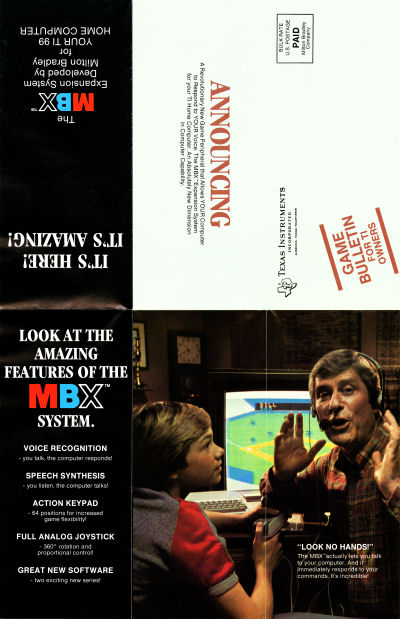 Milton-Bradley MBX Flyer: Side 1
Milton-Bradley MBX Flyer: Side 1
I have a complete MBX system in the box (which may be where I got this flyer), but for some reason I have never used it. I think that’s because I don’t have any of the games that support it — or I didn’t 17 years ago when I first bought my MBX on eBay. Right now I don’t even know what box my MBX is stored in, so it would be hard to rectify that.
Discussion Topic: When was the first time you ever used voice commands with a computer?


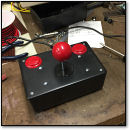

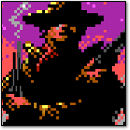
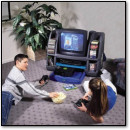
June 15th, 2017 at 12:44 pm
I have never heard of this thing, very interesting. I have a TI-99, I might have to try and find one of these.
June 16th, 2017 at 8:27 am
Trufax: The first time I used voice recognition was on an MBX unit at a relative’s house. It was, ummm, not so impressive once the novelty wore off. Except for sabotaging other people’s games by shouting contradictory commands from behind them. That never got old.
Tangentially, I am PRETTY sure that source is very wrong about Milton-Bradley creating the TMS9918(or 9918a).
Aside from TI being a technology company and M-B being a toy company, there’s the tiny little issue that the chip has a known development team, and they were TI employees.
And, well, if M-B designed a graphics chip in ’78 and shipped half of a game console in ’83, they were REALLY bad at this. Especially since the ColecoVision used the same graphics chip, and M-B would have had a MASSIVE head start. There’s simply no excuse for them to have designed a graphics chip so early while ALSO being so slow to design a system.
…
Though I guess launching the MBX expansion just a few months before TI shuttered the entire home computer division WOULD be evidence that M-B was really bad at this.
June 16th, 2017 at 9:53 am
Yeah, I don’t think MB designed the TMS9918 — that’s a pretty weird thing to say. Perhaps I should have vetted that page’s info before I posted it. I was just trying to be a quick-blogger-like person for once and get something posted. 🙂
June 16th, 2017 at 11:53 am
There was an app bundled with the original SoundBlaster I purchased back in 1990… that was my first exposure.
June 16th, 2017 at 3:34 pm
I actually had one of these! I believe the only game I had for it was baseball which I think is what came with it. It was kinda fun. The technology seemed really cool but actually playing it was okay at best. I thought the keypad overlay was interesting, like a huge version of the Intellivision controller. I haven’t even thought about this thing in decades.
June 22nd, 2017 at 2:28 am
@BenjiEdwards
I was actually surprised to see you paste such a dubious claim, and assumed it simply slipped through the cracks. But I had to call it out anyways… and then I got a bit carried away there.
June 22nd, 2017 at 8:37 am
Yeah, I’m usually very rigorous. I was just lazy this time and wanted to get it up quickly. Oh well — lesson learned!
June 22nd, 2017 at 10:21 pm
Very interesting. I had a TI99/4a, but I also had an Atari 2600, which is where all the gaming happened until we got the Commodore 64. Then the TI and 2600 collected dust. But I still have them.
June 25th, 2017 at 1:53 pm
The headset (with the padded “ear rests”) remind me of the Access Software “Lip Stik” that was bundled with ECHELON, a 3d sandbox space sim that was reminiscent of Elite or Space Rogue but was set on a single world (a newly discovered “captured” planet at the edge of our solar system). The fire button was mimicked by the “microphone”. You had to say “fire” but honestly any loud noise would work; and indeed even without the lipstik you could put another joystick in port 2 and just use it’s fire button. I was sorely disappointed to discover that it did not in fact function as stereo headphones as well as the “voice fire button”.
June 26th, 2017 at 9:04 am
Bill,
I used to have a Konami LaserScope (before I took it apart as a curious young teenager), which is a head-mounted light gun peripheral with built-in headphones for the the NES. Its gimmick was that you could shout “fire!” into its microphone to take a shot instead of pushing a button.
That gimmick lost a lot of its appeal once users realized that literally any sound loud enough would trigger the fire function. So you could just blow into it or tap the microphone to shoot.
Regarding the MBX, the pamphlet does say something about voice training, but I would not be surprised if that is how its headset works as well — just a sound threshold that triggers a button push (this is pure speculation though — I really need to actually try it some day). And also, despite appearances, the headset on the MBX does not have integrated speakers. They’re just foam pads to hold the thing on your head.
July 1st, 2017 at 10:52 pm
Yeah, Benj, that is probably the case (loud noise v. actual voice recognition, something that has only been practical since the late 1990s, in my experience).
I always thought it was cheap of Access to not go the full bug and include actual headphones. I might have used the LipStik more if it had. And, I would imagine, the MBX might’ve had a bigger splash if it had headphones, too.
July 7th, 2017 at 3:42 am
The MBX microphone is at least slightly more refined than “loud noise = button”, as it can respond to multiple unique commands within a single game.
A fact I remember vividly because it was SO fun to walk up behind someone and shout left while he’s saying right, or vice-versa.
There’s certainly not MUCH comparison going on, with limited processor time and RAM space being major obstacles, but there’s some smarts in there.
Probably checking for a pattern of 1-bit spikes, but still… a pattern is better than just “fire”.